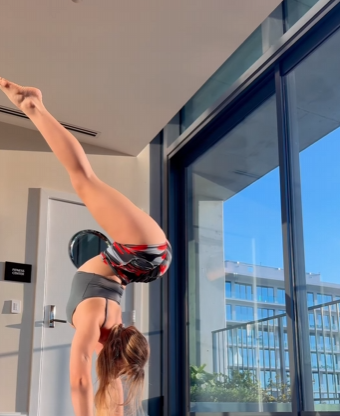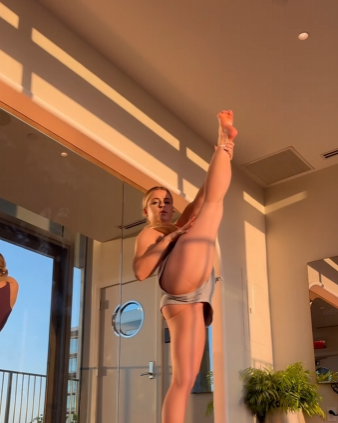
Flexibility is one of the most admired and sought-after attributes in the world of fitness, gymnastics, dance, and martial arts. Among the pinnacle expressions of this flexibility is the “double split”—a phrase that makes enthusiasts light up with excitement and leaves others scratching their heads in awe. But what exactly are double splits, and how does one even achieve such an impressive feat? This article dives deep into the concept, benefits, training process, and challenges of mastering double splits.
What Are Double Splits?
To begin with, a split generally refers to a position where the legs are extended in opposite directions—either forward and backward (front split) or to the sides (middle split). A double split typically refers to someone being able to perform both front splits (left and right leg forward) and a middle split with ease. It showcases not only flexibility but also balance, control, and muscle symmetry. In some interpretations, “double splits” might even refer to doing two kinds of splits simultaneously in choreography or rapidly switching between the two during performance.
For dancers and gymnasts, the double split is a milestone that reflects months—if not years—of dedicated training and patience. It’s more than just a party trick. It’s a physical statement: “I’ve worked hard to control my body, and I’m proud of what it can do.”

Why Train for Double Splits?
You might be wondering—why go through all that effort just to be able to sit on the floor with your legs wide apart?
Well, here’s why:
- Increased Flexibility
Training for double splits naturally increases overall hip, hamstring, and groin flexibility. This is helpful for athletes, dancers, and yogis who need an extended range of motion for performance and injury prevention. - Enhanced Balance and Posture
Flexibility alone isn’t enough; you need control. Training for splits enhances proprioception (your sense of body position), which improves balance and posture. - Reduced Injury Risk
Flexible muscles and joints are less likely to strain under pressure. Double split training conditions the muscles to stretch safely under tension. - Mind-Body Discipline
The process of reaching double splits teaches perseverance, patience, and mindful stretching. You become more aware of your body’s limits and how to gently push past them. - Artistic & Athletic Performance
For performers, double splits make choreography and acrobatics more dynamic. It adds a wow factor on stage or in front of the camera.

How to Train for Double Splits
Achieving double splits isn’t magic—it’s consistent, careful training. Here’s how to break it down.
1. Warm Up First!
Before diving into any stretching routine, always warm up your body. Ten to fifteen minutes of light cardio—like jumping jacks, jogging, or dancing—gets blood flowing and prepares muscles for deeper stretching.
2. Start With Front Splits
Train each side individually. Most people have a dominant and a non-dominant leg, so be sure to stretch both sides equally.
Front Split Drills:
- Low lunge (with knee down)
- Runner’s lunge
- Hamstring stretch with extended front leg
- Supported front split (with yoga blocks)
Be gentle. Don’t force the stretch. Hold each pose for 30 seconds to a minute and breathe deeply.
3. Train Middle Splits
Middle splits (also known as straddle splits) require strong and flexible adductors and hip joints.
Middle Split Drills:
- Butterfly pose
- Wide-leg seated forward fold
- Froggy stretch
- Wall-assisted middle split
If your hips feel tight or stuck, that’s totally normal. Over time, the body will adapt.
4. Incorporate Dynamic and Static Stretching
- Dynamic stretching (like leg swings and controlled kicks) prepares your muscles to stretch while moving.
- Static stretching (holding poses) increases your range over time. Both are necessary.
5. Strengthen While You Stretch
Building strength in your glutes, hamstrings, and core helps stabilize your joints. This prevents injury and allows you to hold your split positions longer and safer.
Try incorporating:
- Glute bridges
- Core planks
- Hamstring curls
- Hip abduction and adduction exercises
6. Be Consistent
Flexibility training should be done at least 3-5 times per week for best results. Even just 15-30 minutes a day can make a difference.
Challenges Along the Way
No one reaches double splits overnight. Here are a few common challenges and how to deal with them:
- Tight hamstrings or hips – Use foam rollers, massage balls, or warm baths to help release tension.
- Pain vs. Discomfort – Stretching should feel intense, not painful. Sharp pain means you’re overdoing it.
- Plateaus – Sometimes progress stalls. Try switching up your routine or working with a flexibility coach.
- Mental fatigue – The journey can feel long. Celebrate small victories along the way.

Tips for Safer and Smarter Splits Training
- Never bounce in a stretch. It risks tearing muscle fibers.
- Use props like yoga blocks, bolsters, or straps to support your form.
- Film your progress to stay motivated.
- Listen to your body! Rest days are just as important as stretch days.
- Stay hydrated—flexible muscles need water.
Celebrating Your Double Splits Success
Finally getting into your first full double splits is a thrilling moment. Whether you’re a beginner or someone returning after a break, every inch of progress matters. Some people post their success on social media, others simply smile in the mirror and say, “I did that.”
The coolest part about achieving double splits is that it often opens the door to other movements—like advanced yoga poses, higher ballet kicks, and deeper martial arts stances. It’s not just a destination—it’s a beginning.
Final Thoughts
Double splits may look extreme, but they’re surprisingly achievable with the right mix of patience, consistency, and respect for your body’s limits. It’s not about being a contortionist; it’s about being the best version of yourself—one stretch at a time.
So the next time someone says, “Double splits? No way!”—you can smile and say, “Watch me.”
Whether you’re on your mat, in the gym, or on a dance floor, just remember: progress is a split decision away.



